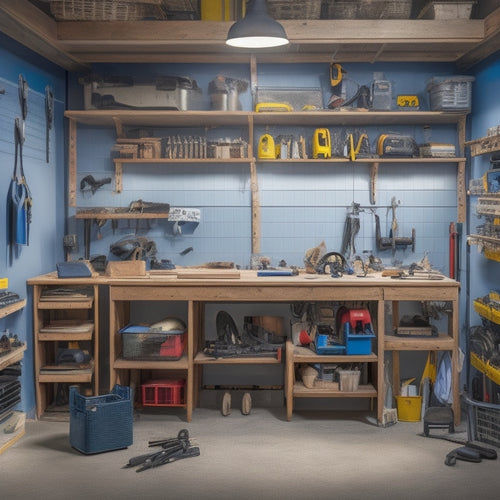
7 Budget-Friendly Tips for Home Renovation Supplies
Share
When renovating your home, supplies can be a significant expense, but with the right strategies, you can cut costs without sacrificing quality. Shop during off-peak seasons for discounts on materials and fixtures, and consider buying in bulk to negotiate better prices. Don't overlook second-hand options, like online marketplaces and salvage yards, for gently used materials at lower costs. Take on DIY projects to save on labor costs, and opt for cheaper alternatives like generic or store-brand options. Repurposing and reusing materials can also reduce waste and expenses. By negotiating with suppliers and being willing to walk away, you can find even more ways to stretch your budget - and there are more tips to discover.
Key Takeaways
• Shop during off-peak seasons for significant discounts on materials and fixtures, and negotiate labor costs with contractors.
• Buying in bulk can lead to economies of scale and better pricing negotiations, especially for large quantities of materials like lumber and flooring.
• Consider second-hand options like online marketplaces, salvage yards, and thrift stores for gently used materials at lower costs, supporting sustainable living practices.
• DIY minor repairs and cosmetic updates to save on labor costs, which can range from 10-70% depending on the task and skill level.
• Negotiate with suppliers, understanding market value, and be willing to walk away from unfavorable deals to get the best prices for your renovation supplies.
Shop During Off-Peak Seasons
By planning your shopping trips during off-peak seasons, you can snag significant discounts on materials and fixtures, which can add up to substantial savings on your overall renovation budget. This strategy is especially effective for non-essential items, like decorative fixtures or luxury materials, that can be purchased at a fraction of the cost during seasonal sales. For instance, if you're planning a kitchen renovation, consider buying appliances during holiday weekends or special promotional events when retailers offer discounts.
Additionally, consider the renovation timing and plan your project during the off-season, typically during the winter months when demand is lower. This can result in better deals on labor costs, as contractors may be more willing to negotiate prices to secure projects during the slower period.
Buy in Bulk and Save
You can further stretch your renovation budget by adopting a bulk purchasing strategy, which allows you to capitalize on economies of scale and negotiate better prices with suppliers. This approach is particularly useful when you need large quantities of materials, such as lumber, drywall, or flooring. By buying in bulk, you can reduce the cost per unit and enjoy significant savings.
Additionally, you can take advantage of warehouse deals, which offer discounted prices on bulk orders. Be certain to calculate your material needs carefully to avoid overbuying, and consider partnering with a contractor or builder to split bulk orders and share the costs.
When buying in bulk, it's important to research suppliers and compare prices to guarantee you're getting the best deal. Look for wholesale distributors, online retailers, or local suppliers that offer bulk discounts. You can also negotiate with suppliers to further reduce prices or ask about any additional discounts they may offer.
Consider Second-Hand Options
Explore online marketplaces, salvage yards, and Habitat for Humanity ReStores to uncover gently used materials that can be repurposed for your renovation project at a fraction of the cost of new materials.
You'll be amazed at the hidden gems you can find, from reclaimed wood to vintage fixtures. Online marketplaces like Craigslist, Facebook Marketplace, and Letgo often have people giving away materials for free or at a low cost. You can also score thrift store finds, like gently used appliances or building materials, at a fraction of the original price.
When shopping second-hand, make sure to inspect the materials carefully before purchasing. Look for any damage, wear, or needed repairs. Consider the materials' original quality, durability, and functionality.
With a little creativity and elbow grease, you can breathe new life into these reclaimed materials. By incorporating second-hand options into your renovation, you'll not only save money but also reduce waste and support sustainable living.
DIY Instead of Hiring
Taking on certain tasks yourself can greatly slash your renovation budget, especially when it comes to minor repairs, cosmetic updates, and labor-intensive projects that don't require specialized skills. By doing it yourself, you'll not only save on labor costs but also develop new skills and gain a sense of accomplishment. Here are some tasks you can consider taking on:
| Task | Skill Level | Cost Savings |
|---|---|---|
| Painting | Beginner | 50-70% |
| Tiling | Intermediate | 40-60% |
| Installing shelves | Beginner | 30-50% |
| Caulking | Beginner | 20-40% |
| Demolition | Beginner | 10-30% |
Opt for Cheaper Alternatives
Renovating on a budget often requires getting creative with materials, which is where opting for cheaper alternatives can make a significant dent in your expenses. You don't have to sacrifice material quality to save money; you just need to think outside the box and explore alternative sources.
Here are some ways to opt for cheaper alternatives:
-
Shop during sales: Keep an eye on your local hardware store's sales and discounts to snag materials at a lower price.
-
Consider used or recycled materials: Websites like Craigslist or Habitat for Humanity ReStores often have gently used materials at a fraction of the cost.
-
Look for generic or store-brand options: Instead of buying name-brand materials, opt for generic or store-brand alternatives that are often cheaper.
-
Negotiate with suppliers: If you're buying materials in bulk, try negotiating the price with your supplier.
-
Get creative with substitutes: Think about whether there's a cheaper substitute for a particular material. For example, using engineered wood instead of solid hardwood can save you hundreds of dollars.
Repurpose and Reuse Materials
Repurpose and Reuse Materials
By repurposing and reusing materials, you can not only reduce waste but also cut costs, as you'll need to purchase fewer new materials for your renovation project. This approach requires some creative thinking, but the payoff is well worth it. Consider material swapping with friends, family, or online communities to exchange materials you no longer need for ones that fit your project.
Here are some inspiring examples of creative upcycling:
| Material | Original Use | New Use |
|---|---|---|
| Old pallets | Shipping crates | Coffee tables or shelving units |
| Glass jars | Food storage | Pendant lights or vases |
| Brick | Outdoor paving | Indoor accent walls or fireplaces |
Negotiate With Suppliers
When you're ready to purchase materials for your home renovation, don't be afraid to negotiate with suppliers.
You'll be surprised at how much you can save by doing your research and being willing to make a deal.
Know Your Market Value
By understanding the market value of materials and labor, you'll be empowered to negotiate with suppliers and contractors to get the best deals for your home renovation project. This knowledge gives you leverage to make informed decisions and avoid overpaying. Conduct thorough market research to determine the average cost of materials and labor in your area. You can also consult with a property appraisal expert to get a better understanding of your home's value and how it compares to others in the neighborhood.
Here are some benefits of knowing your market value:
-
You'll be able to identify and avoid inflated prices.
-
You'll have a clear idea of how much you're willing to pay for materials and labor.
-
You'll be able to make more informed decisions about where to splurge and where to cut costs.
-
You'll have a stronger bargaining position when negotiating with suppliers and contractors.
-
You'll be able to create a more realistic budget and stick to it.
Be Willing to Walk
With a clear understanding of your market value, you're now equipped to negotiate with suppliers and contractors, and being willing to walk away from a deal can be a powerful tool in your negotiation arsenal. This doesn't mean you're being unreasonable or difficult; it means you're confident in your research and willing to stand up for your budget.
Here are some scenarios where being willing to walk can benefit you:
| Scenario | Benefit |
|---|---|
| Supplier is unwilling to meet your price | You can find a better deal with a competitor |
| Contractor is pushing for a more expensive material | You can opt for a more sustainable, cost-effective option |
| Delivery timeline is too long | You can explore local resources for faster delivery |
| Supplier is adding unnecessary fees | You can renegotiate or find a supplier with more transparent pricing |
| Contractor is not willing to work with your sustainable transportation options | You can find a contractor who shares your values |
Ask About Discounts
You can uncover hidden savings by directly asking suppliers if they've any discounts available for your home renovation project. Don't assume that the prices they quote are set in stone. Suppliers often have wiggle room to negotiate, especially if you're making a large purchase or committing to a long-term partnership.
Here are some ways to tap into discount programs and strengthen your supplier partnerships:
-
Volume discounts: Ask if they offer lower prices for bulk orders or repeat business.
-
Loyalty programs: Inquire about rewards or special pricing for loyal customers.
-
Floor models or display items: Check if they've discounted prices for display items or floor models that are still in great condition.
-
Scratch and dent sections: Look for discounted items with minor cosmetic damage.
-
Seasonal promotions: Ask if they've any promotions or sales coming up during slow seasons.
Frequently Asked Questions
Can I Return or Exchange Defective Materials From a Discount Store?
When dealing with defective materials from a discount store, you'll want to know your options.
Can you return or exchange them? It depends on the store's return policies and exchange procedures. Always check the store's website or ask a sales associate about their policies before making a purchase.
If you've already bought the materials, review your receipt and packaging for return or exchange instructions.
Don't be afraid to ask about restocking fees or time limits for returns. Knowing the rules will save you time and hassle.
How Do I Ensure the Quality of Second-Hand Renovation Supplies?
When sourcing second-hand renovation supplies, you'll want to develop a keen eye for quality.
Start by inspecting items thoroughly for signs of wear or damage. Research the original manufacturer and model to gauge its reputation and performance.
Implement quality assessment strategies like testing electrical components or examining materials for deterioration.
Don't be afraid to negotiate prices or walk away if you're unsure.
Are There Any Hidden Costs to DIY Renovation Projects?
You might be surprised to learn that 75% of DIY renovation projects go over budget!
When taking on a DIY project, you're likely to encounter unexpected expenses that can quickly add up. Delays in material delivery or permits can also cause project delays, further increasing costs.
To avoid these hidden costs, carefully plan and research your project, and always pad your budget by 10-20% to account for unforeseen expenses.
Can I Use Reclaimed Wood for Load-Bearing Structures Safely?
You're considering using reclaimed wood for load-bearing structures, but you're right to question its safety.
While reclaimed wood can be a great eco-friendly option, it's vital to guarantee its structural integrity. You'll need to inspect the wood for signs of decay, cracks, or pest damage.
Additionally, consult with a professional to determine the wood's load-bearing capacity and verify it meets local building codes.
With proper evaluation and planning, you can safely use reclaimed wood for load-bearing structures.
Do Suppliers Offer Discounts for Long-Term or Repeat Customers?
You're likely wondering if suppliers offer discounts for long-term or repeat customers. The answer is yes!
Building supplier loyalty can lead to significant savings. As a repeat customer, you're in a strong position to negotiate better prices.
Don't be afraid to ask your supplier about loyalty programs or discounts for bulk orders. By doing so, you'll be able to capitalize on your customer negotiation power and get the best deal possible.
Conclusion
You've survived the gauntlet of DIY renovation on a shoestring budget.
Pat yourself on the back for not losing your mind (completely) while maneuvering the chaotic world of discounted tile and second-hand screws.
Now, go forth and enjoy your slightly-less-broken bank account and newly renovated home, where the faint scent of compromise and sacrifice wafts through the air.
Related Posts
-

Why Home Renovators Need Smart Tool Storage Now
You need a smart tool storage system that streamlines your workflow, reduces clutter, and protects your investments b...
-

Why Renovation Waste Disposal Harms the Environment
When you undertake a renovation project, you're contributing to a staggering problem: renovation waste disposal, whic...
-

Top 3 Tools to Buy for Stucco Renovation
You'll need the right tools to guarantee a successful stucco renovation, and it all starts with three essential items...


